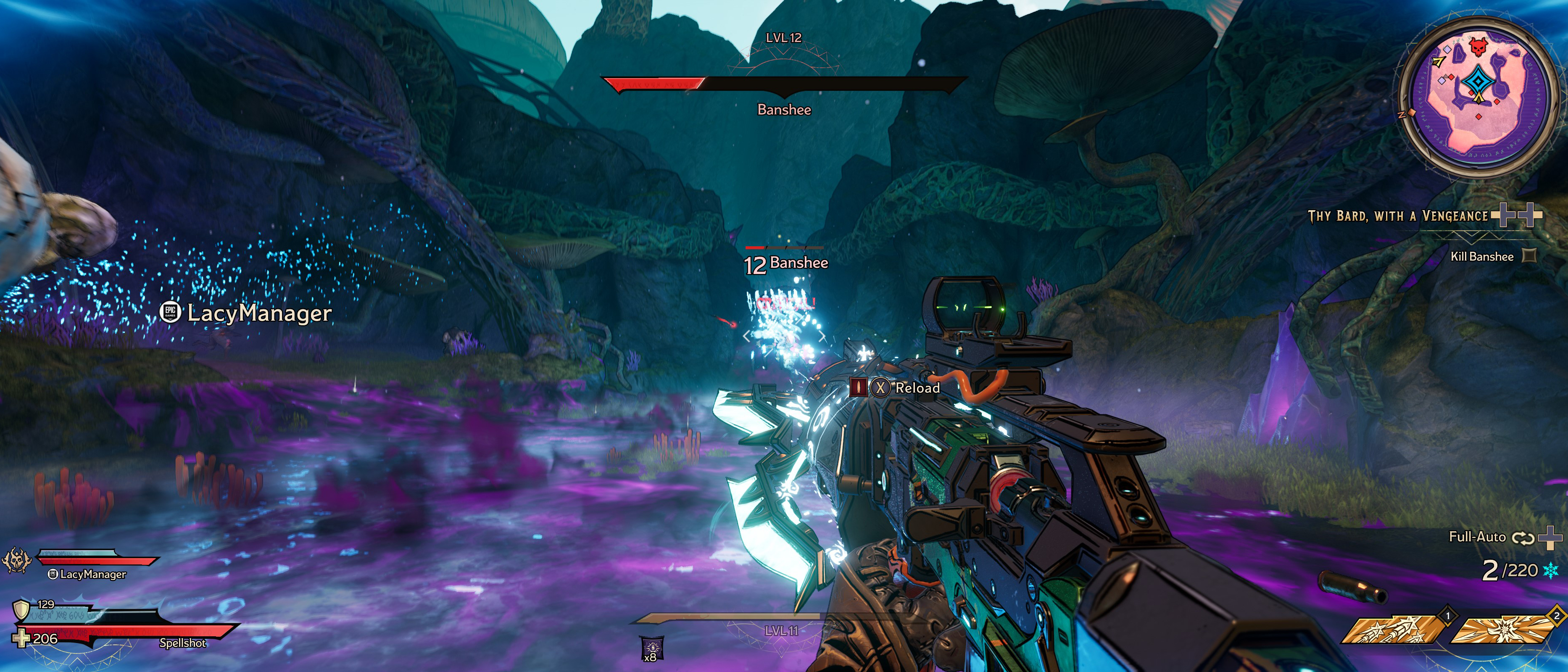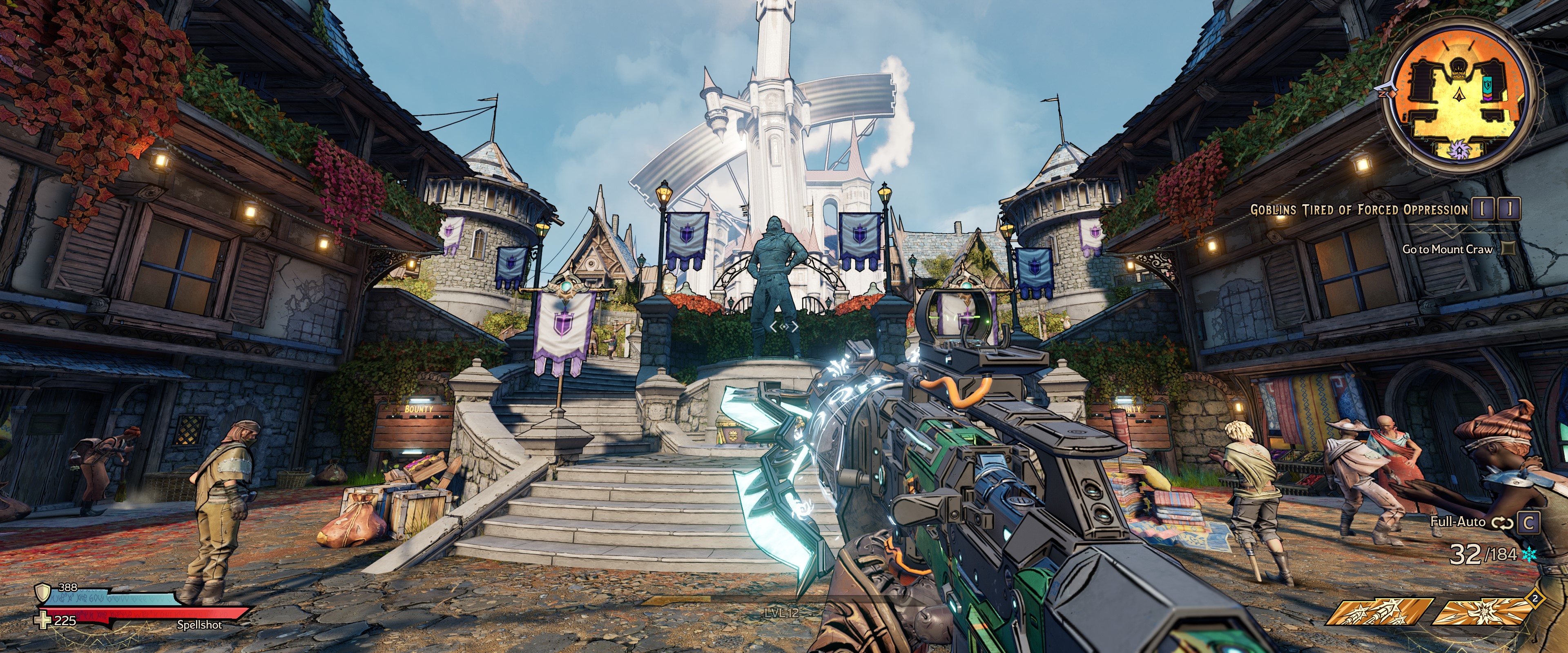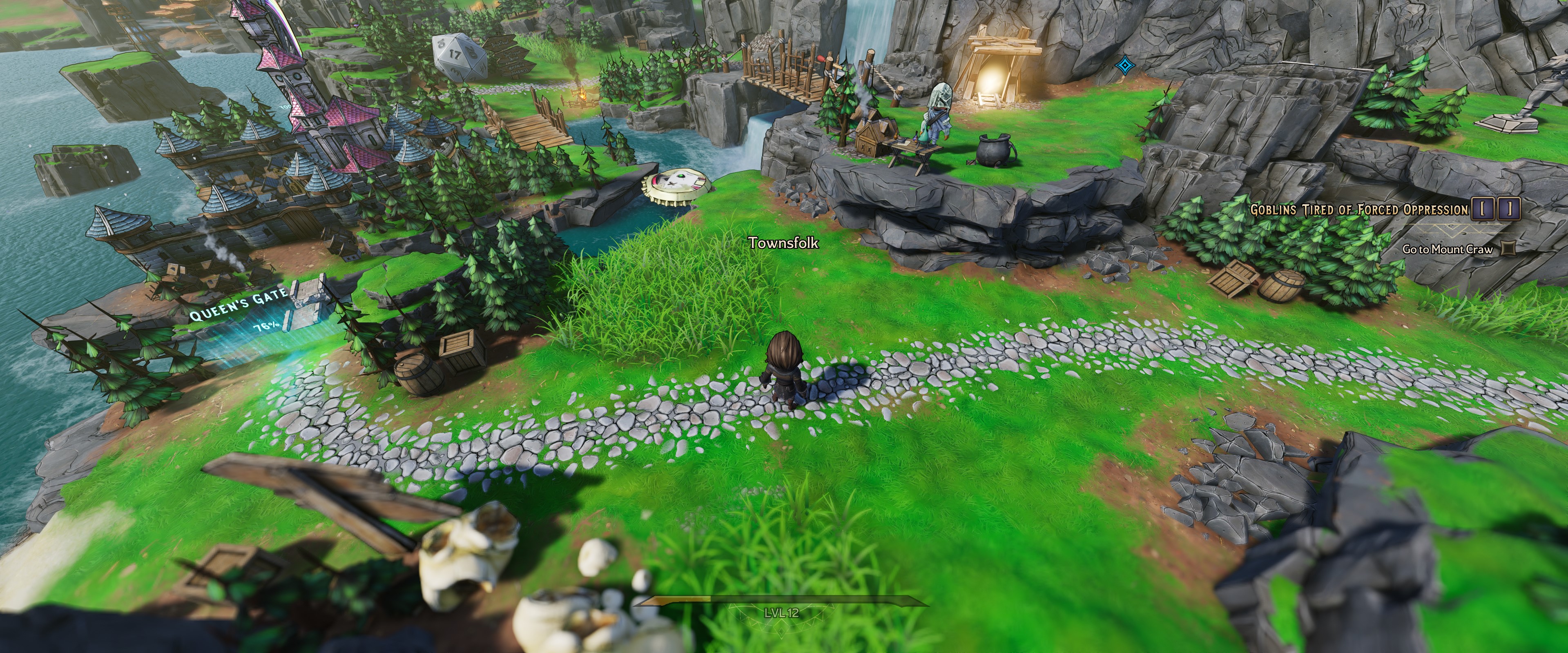Laptop Mag Verdict
Tiny Tina’s Wonderlands takes everything we love from D&D and throws it into the infamous Gearbox gun generator — it’s a magical blast.
Pros
- +
Inclusive character creation
- +
Magic go boom
- +
More classes than players
- +
Multiclassing is sick
- +
D&D everywhere
Cons
- -
Open world would’ve been nice
- -
Inventory and item issues
Why you can trust Laptop Mag
Tiny Tina’s Wonderlands feels like the work of a think tank specifically tasked with getting Rami Tabari to fall in love with this Borderlands spin-off. I’ve played Borderlands before and I’ve never been a fan — it just didn’t click with me, but Wonderlands absolutely works for this D&D addict.
From the detailed character customization and creative classes to the mish-mash of Dungeons & Dragons inside jokes and the addition of spellcasting, Tiny Tina’s Wonderlands is practically everything I wanted from Gearbox. It’s not perfect; there are some glaring issues with the inventory and item systems. I also would have preferred a true open world, but when I’m not playing Tiny Tina’s Wonderlands, I’m thinking about Tiny Tina’s Wonderlands.
Tiny Tina’s Wonderlands, without a doubt, belongs on our shortlists for best PC games, best PS5 games, and best Xbox Series X games.
Nerdy-ass friends playing Bunkers & Badasses
Tiny Tina's Wonderlands starts how every D&D game starts — crashing into a mountain thanks to an unreliable Andy Samberg, or something. But seriously, this game is a love letter to TTRPG fans, and you’d be doing yourself a disservice by skipping it.
Tiny Tina's Wonderlands truly captures the experience of playing with friends at home with a humble dungeon master (DM). Sure, there are obvious references to D&D, but there are also many inside jokes that no one will understand unless they've played the game. For example, the DM getting flustered and coming up with things on the spot — this is reflected in the game by certain objects popping up in the world as Tina describes them. Or explicitly telling the player not to do something — only for them to do it and get killed. There's even a moment where I seduced a bridge to open up for me.
The narrative of Tiny Tina's Wonderlands doesn’t matter as much as how much fun you’re having with your friends. Sure, you have to stop the dragon lord something-something and save the world yada-yada. What the game lacks in a compelling story it makes up for with its presentation. That’s how Tiny Tina hooks you in.
The DM-to-player narrative device works incredibly well for video games because you can explain away almost every facet of the game by being a part of a character's imagination. Nothing has to make sense, and Wonderlands takes that concept and runs away with it by throwing in wacky plot devices and twists your way. They’re borderline cliche, but well executed.
Sign up to receive The Snapshot, a free special dispatch from Laptop Mag, in your inbox.
Every character bleeds with dumb fun, and when backed by excellent talent like Ashly Burch, Will Arnett, Andy Samberg and Wanda Sykes, Tiny Tina's Wonderlands is like stepping into a D&D game with some of the funniest people on Earth.
Roll your character!
Ugh, I love this character customization! It makes me feel like I’m rolling an actual D&D character. Well, it’s not as complex, but it’s definitely inspired.
The first tab has to choose a class: Brr-Zerker (Similar to D&D’s Barbarian), Stabbomancer (Rogue), Clawbringer (Paladin/Ranger), Spellshot (Wizard/Sorcerer), Graveborn (Warlock) or Spore Warden (Druid). I went with the Spellshot to recreate my favorite D&D character, Captain Kaz, a badass pirate sorcerer with a heart of fire. This class not only lets me cast more than one spell, but it also lets me use Polymorph magic, turning enemies into skeeps (enchanted sheep). The Spellshot also does more spell damage than any other class in the game. Don’t worry too much about your class choice — later in the game you’ll get access to multiclassing, so you can really experiment with your build.
The second tab is all about your character looks. In the Body and Personality section, you can dictate your body type, This One (fem-appearing) or That One (masc-appearing), body size and head size. In the personality portion, there are options for your voice type and pitch as well as your pronouns, which is awesome. There are the Facial Features and Face Decoration sections where you get into the crux of your character’s design, which is remarkably detailed considering the game’s cartoonish art design. In Armor Decoration, you can switch up your style, which is limited in scope only because the starting armor doesn’t look interesting. There’s also a Presets section if you’re not feeling very creative.
The third tab is where you select your character background (my favorite part about D&D). Unfortunately, the backgrounds are limited to only five choices: Village Idiot, Raised by Elves, Failed Monk, Recovering Inventory Hoarder and Rogue Alchemist. The story backgrounds themselves don’t matter as much as the stat benefits they provide. And since there are six stats, having only five backgrounds is limiting the creativity of the stat spread. I felt this when I created my Spellshot and the recommended stats were Intelligence and Dexterity, but there’s no background that prioritizes both at the same time. In fact, both Intelligence-based backgrounds had negative marks to Dexterity.
The four tab is where you get to dish out some Hero Points to your stats. There’s Strength (Crit Damage), Dexterity (Crit Chance), Intelligence (Spell Cooldown), Wisdom (Status Damage), Constitution (Max HP/Ward) and Attunement (Skill Cooldown). The names of the stats are basically identical to D&D, except for Attunement, which is a replacement for Charisma. You get 10 Hero Points to spend — I recommend bumping those negative stats to a flat 10, and then focusing on your primary stats. I dumped all my points into Intelligence for my Spellshot.
Finally, the last tab lets you choose a name for your character, which may be the tab you spend the most on for some. Overall, character creation is surprisingly in-depth, especially for a series that has never let you create your own character. It’s one of the better character creators I’ve seen, and I am that much more connected to my character because of it.
Swords, magic and… guns?
I was hoping that Tiny Tina’s Wonderlands would go full fantasy, but in true Borderlands fashion guns are practically falling from the sky. Each character is equipped with several guns, a melee weapon, and at least one spell. The spells and melee weapons act similarly to the guns in that they are randomly generated with all sorts of different stats.
The guns in Tiny Tina’s Wonderlands are wacky, whimsical and brutal. Each one is packed with its own unique fantastical element. For example, shotguns have a cauldron of crystals built atop of it that consists of its ammo, and to reload, you have to sprinkle some dust on top of it. It’s goofy as hell, but that’s the point. Another one of my favorite weapons has more of a sci-fi vibe; there’s this pistol with an engine attached to the bottom of it, and you have to rev it up each time you pull it out. When it’s ready, you can fire endlessly until the engine overheats. I appreciate how wild the guns get, especially to the point where there are unique animations for its wackiness.
Starting as a Spellshot, I dove head first into the magic of Tiny Tina’s Wonderlands. At first, I was underwhelmed, but once I started barreling through the story, I unlocked more spells. My current favorite is almost any variation of Eruption because the character snaps their finger in order to cast the spell, and that’s literally what my D&D character does when casting any spell. I’m telling you that this game was designed specifically with me in mind, and I thank whoever the hell you are.
I have some issues with the Spellshot, however. I don’t like that you must choose between Polymorph and a second spell — it would be cool if all classes could have both of their main abilities equipped at once. I’ve also been dumping all of my points into Intelligence, and I’m pretty close to my 32-point cap, but my spell cooldown doesn’t feel as quick as I’d like. I haven’t capped out my skills just yet, so there’s an opportunity to increase it, but the stats should have more of an impact than a 1% tick each level.
The melee in Tiny Tina’s Wonderlands is fine — it’s too sluggish and doesn’t feel very impactful, but it’s not a weapon you want to be using consistently anyway. However, this could be an issue with classes like Brr-Zerker and Stabbomancer; they rely on melee weapons.
Jump into that TPK!
Tiny Tina is a great Bunker Master and deserves praise for her solid improv and patience when dealing with ungrateful ass players. Seriously though, Gearbox has crafted quite the magical world in Tiny Tina’s Wonderlands. From the whimsical world design to the epically crafted boss encounters, I am enjoying Tiny Tina’s Wonderlands. Here’s a shortlist of praises and complaints.
I wasn’t a fan of the art style in previous Borderlands games, but Tiny Tina’s Wonderlands looks more refined and polished. The levels don’t look like a cell shaded mess of assets; it’s sharp and vibrant.
It’s a small thing, but I love the way Tiny Tina’s Wonderlands handles its difficulty: the hardest mode gives you more rewards. Every game should adopt this design philosophy; reward your players for the punishment!
The boss fights feel like raid bosses. I loved my time fighting Banshee — my sister and I had to jump around the arena to actively avoid Banshee’s deadly fog and their blast-waves of force. We were knocked out several times, but we ended up making our death saves (killing an enemy to revive yourself). Will Arnett’s character even made a joke that Tiny Tina was trying to TPK (total party kill) us.
I’d sell my soul for another d20 — no seriously, I would. I love the Lucky Dice system in Tiny Tina’s Wonderlands. It gives you the chance to collect some better loot while also providing a fun collectable-hunting activity. The best part is that your loot gets better with every new dice you find.
Instead of a fully fleshed out open world, Tiny Tina’s Wonderlands features a goofy board that represents where our characters are in the real world. You can move around, explore, pick fights, and travel to your appropriate destinations. While it is cute, I would have preferred an open world that fed into each area. I love that this game leans into the goofiness of D&D, but it should equally lean into the flair and wonder of the tabletop RPG as well.
The Item Score system in Tiny Tina’s Wonderlands is arbitrary and makes no sense. I’ve seen low-scored items completely destroy higher scored items. Either get rid of Item Score or fine-tune it to be more helpful for players who don’t have the time to read through every stat and bonus on an item card.
Why, for the love of all that is holy, is there an inventory limit? No, I don’t care that I can buy inventory upgrades. If your game’s mechanics isn’t inherently dependent on inventory management (like Resident Evil and No Man’s Sky), then you should not have an inventory limit. Gearbox should know better considering it developed a system that creates an seemingly infinite variety of weapons. Even Elden Ring knows better.
Tiny Tina’s Wonderlands PC performance
I have encountered several issues while playing Tiny Tina’s Wonderlands, but there isn’t enough to hinder gameplay progression. Also, keep in mind that I played a review build — not the same version of the game that’s rolling out on launch day.
There are certain graphical effects, like floating magical crystals, that drop my frames from 60 frames per second to 19 fps — unless I jump from Badass to High (skipping over Ultra). There have been several cases where the person that I’m playing with sees something that I don’t in the world, and then I will see it after it’s meant to show up in the world. We’ve also found that at least one of the weapons doesn’t fire — no bullets, rockets or magic pew-pews come out of that thing.
Overall, Tiny Tina’s Wonderlands is relatively smooth to run. Here are all of the included options that you can mess with in the graphics settings.
Basics — General:
- Graphics API: DirectX 11, DirectX 12
- Display: (varies by setup)
- Display Mode: Full Screen, Windowed Borderless, Windowed
- Resolution: (varies by setup)
- Vertical Sync: Off, On
- Resolution Scale: 50% - 200% in 25% increments
- Limit Frame Rate: Smooth 22-62 FPS, Capped 30 FPS, Capped 50 FPS, Capped 60 FPS, Capped 72 FPS, Capped 120 FPS, Unlimited, Custom
- Custom FPS Limit: default 90, minimum 15, maximum 300
- Calibrate Display: Brightness and HDR
- Field of View: default 90, minimum 70, maximum 110
Advanced — General:
- Graphics Quality: Very Low, Low, Medium, High, Ultra, Badass
- Anti Aliasing: None, FXAA, Temporal
- Texture Streaming: Low, Medium, High, Ultra
- Material Quality: Low, Medium, High, Ultra
- Anisotropic Filtering: Trilinear, 2x, 4x, 8x, 16x
- Shadows: Low, Medium, High, Ultra
- Display Stats: Off, FPS, All (FPS, CPU, GPU)
Environment:
- Draw Distance: Low, Medium, High, Ultra
- Clutter: Low, Medium, High, Ultra
- Terrain Detail: Low, Medium, High, Ultra
- Foliage: Low, Medium, High, Ultra
- Volumetric Fog: Low, Medium, High, Ultra
- Screen Space Reflections: Off, Medium, High, Ultra
Characters:
- Character Detail: Low, Medium, High, Ultra
Post Processing:
- Ambient Occlusion: Off, Low, Medium, High, Ultra
- Camera Motion Blur: Off, On
- Object Motion Blur: Off, On
- FidelityFX Sharpening: Off, On
Tiny Tina’s Wonderlands PC benchmarks and requirements
I tested Tiny Tina’s Wonderlands with my desktop Nvidia GeForce RTX 3080 GPU with 10GB of VRAM at 3840 x 1600 on Badass settings via the game’s convenient benchmark, and my PC ran it at an average of 74 frames per second.
My sister also ran it on a desktop Nvidia GeForce GTX 1070 GPU with 8GB of VRAM at 3440 x 1440 on Medium settings and got 48 fps. On High and Ultra settings, the GPU averaged 33 fps and 30 fps, respectively. On Badass, the GPU trailed behind at 27 fps.
If your PC is a couple of generations behind, I recommend playing Tiny Tina’s Wonderlands on the Xbox Series X or PS5, which will net you super-fast load times and more detailed graphics.
The minimum requirements for a system to run Tiny Tina’s Wonderlands is an AMD FX-8350 or Intel i5-3570 CPU, an AMD Radeon RX470 or Nvidia GeForce GTX 960 4GB GPU and 6GB of RAM. The recommended specs are an AMD Ryzen 5 2600 or Intel i7-4770 CPU, AMD Radeon RX 590 8GB or Nvidia GeForce GTX 1060 6GB GPU and 16GB of RAM.
Bottom line
If you are a fan of Borderlands or a TTRPG aficionado, I cannot recommend playing Tiny Tina’s Wonderlands enough. Besides being incredibly charming and a visual joy, the gameplay is hella fun. I’ve put over a dozen hours into it so far, and I’m dying to play more.
I haven’t gotten to the end game yet, so I can’t quite comment on how the replayability lives up to other long-lasting titles. However, you can expect a follow-up piece from me either complaining or praising it in typical Rami Tabari-branded rant fashion.
In the meantime, roll them characters!

Rami Tabari is the Reviews Editor for Laptop Mag. He reviews every shape and form of a laptop as well as all sorts of cool tech. You can find him sitting at his desk surrounded by a hoarder's dream of laptops, and when he navigates his way out to civilization, you can catch him watching really bad anime or playing some kind of painfully difficult game. He’s the best at every game and he just doesn’t lose. That’s why you’ll occasionally catch his byline attached to the latest Souls-like challenge.






